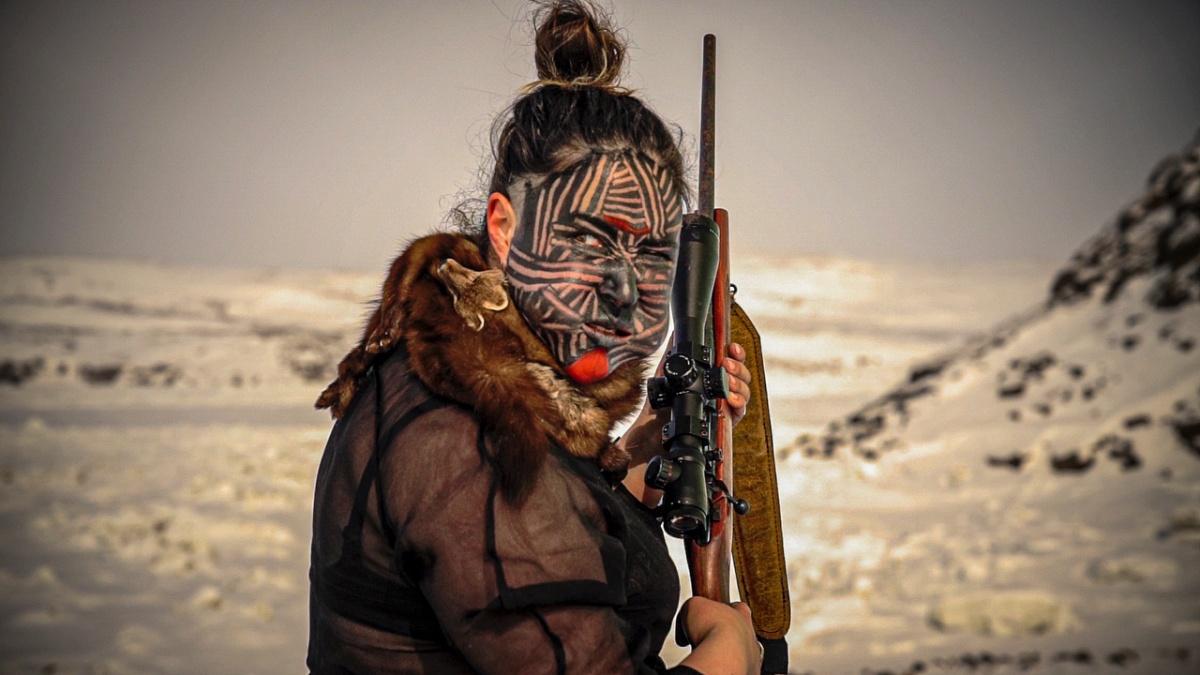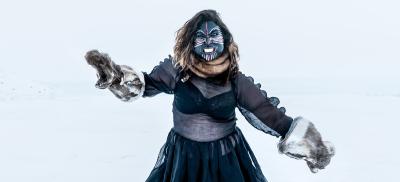Sila through generations
ᓛᒃᑯᓗᒃ Laakkuluk's mother, Dr. Karla Jessen Williamson, discusses the artist's AGO installation.

Laakkuluk Williamson Bathory and Jamie Griffiths, Film still from Silaup Putunga, 2018. Art Gallery of Ontario, purchased with funds from the Joan Chalmers Inuit Art Fund, 2019. © Laakkuluk Williamson Bathory and Jamie Griffiths. Photo courtesy Jamie Griffiths.
Naak silavit qeqqa?, a multimedia installation by acclaimed Kalaaleq artist Laakkuluk, deeply impacts all who visit. On view at the AGO since July, it incorporates video, soundscape and sculpture and seeks to describe sila, the all-powerful Inuktitut word that captures the universe, the environment and the intellect.
The installation includes a selection of Inuit soapstone sculptures from the AGO’s Williamson Collection, donated by Laakkuluk’s parents – Dr. Robert G. Williamson, O.C. and his wife, Dr. Karla Jessen Williamson. The sculptures were made by artists in the Kivalliq region during the initial phase of relocation to colonial settlements.
Back in August, we spoke to Laakkuluk about the installation and learned more about her inspiration for creating the work. During our conversation, she fondly remembered her childhood, and first being asked the riddle –“Naak silavit qeqqa?” (Where is the middle of your sila?) – by her mother. So, for further insight, we reached out to Laakkuluk’s mother, Dr. Karla Jessen Williamson, to ask about the origins of sila, The Williamson Collection, and her thoughts about her daughter’s acclaimed art practice.
Foyer: Can you share some of the inception story of the Williamson Collection of soapstone sculptures? How was it formed over the years? What made you and your husband decide to donate it to the AGO?
Jessen Williamson: I came to Canada [from Greenland] in 1978 and met my husband shortly after my arrival to Saskatoon. He is a fluent speaker of the Inuktitut and was a very fascinating person. He adorned his house with carvings and told me that he knew each of the carvers, individually and could tell authentic stories about each.
He had bought them directly from the carvers, mainly in Kangillineq/Rankin Inlet and area. He stored the carvings in boxes in the basement. I deeply felt their presence of being stored at 1017 Temperance Street, Saskatoon and told him that the carvings had to be somewhere where they can be enjoyed, not in a basement of a house.
My husband connected with Dr. Peter Millard, professor of the English Department at the University of Saskatchewan, to see if a donation could be made. Dr. Ron Marken, also from the Department of English, took photos of each of the carvings and that is how these were presented to the AGO. They were already known to have Inuit sculptures, and this enticed my husband. At the time, AGO had a curator of Inuit Art, Norman Zepp, who helped make the donation happen.
Foyer: The name of Laakkuluk’s installation is “Naak silavit qeqqa?” (Where is the middle of your sila?). During our interview with her, she spoke fondly of you asking her this question/riddle as a child. Can you share with us some of your memories of those moments, and your thoughts about the importance of this question for children?
Jessen Williamson: The term sila is well used in the Inuit languages. It is about weather, the outside, and the universe. My own paternal aunt asked me when I was about five years old where the middle of my sila was? It was a really puzzling question…since I had no idea where the middle of the universe, the weather, or the outside was. The same term is used for intelligence… how could anyone find one’s middle of intellect? I pointed at my forehead, and my aunt just laughed and laughed at me. Rightfully so, where is the middle of the universe? Your intellect, the weather?
Foyer: Have you had a chance to see the installation? (whether digitally or in-person). What are some of your favourite things about it?
Jessen Williamson: No, I have not had a chance to look at the installation, but I am exceedingly pleased that Laakkuluk made a concerted effort to connect to the descendants of the carvers in Kangilliniq/Ranking Inlet, and Arviat. I have encouraged Laakkuluk to find ways for the exhibit to travel to Kangilliniq/Rankin Inlet for the descendants to take pride in their ancestral carvers. Each one of the carvers are profound philosophers and were profound knowledge holders in their own right.
Foyer: What are your thoughts about your daughter’s art practice at-large? Are there any works in particular that resonate with you the most?
Jessen Williamson: Laakkuluk has internalized everything that she was taught by me and her late father. I am exceedingly pleased about the fact that she is always grounded in the world of her parents. She speaks to the Inuit audience as she speaks to the English-speaking audience. This is a very difficult platform as it can easily divide a person into cultural polarization. She is doing a remarkable job and her Inuit community is staunchly behind her unique presentation. Her heart is always right there.
Naak silavit qeqqa? is on view in the AGO’s Fudger Rotunda (gallery 126) through June 2023.

